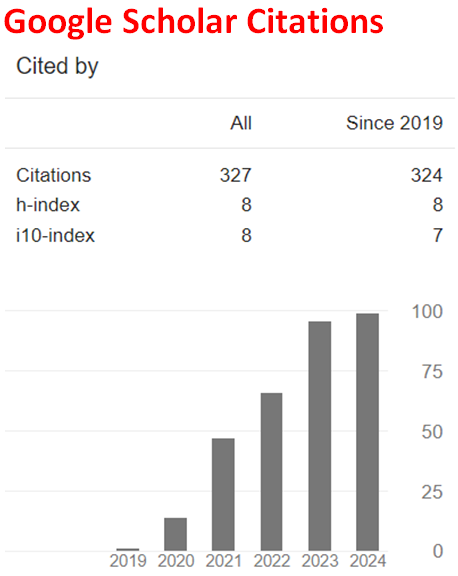Investigating the bioactive compounds and characterization of Guiera senegalensis aqueous extract
Abstract
The growing demand for plant-based medications raises concerns about overharvesting and biodiversity loss. Integrating traditional medicine with modern techniques is becoming popular, especially in areas with limited access to conventional medicine. The West African native plant Guiera senegalensis, known for its numerous medicinal uses, is widely employed in traditional medicine. The demand for affordable treatments using bioactive chemicals is increasing. Therefore, this study aimed to characterize the bioactive compounds present in the aqueous extract of Guiera senegalensis leaves.
Aqueous extracts from Guiera senegalensis leaves were prepared and analyzed using Fourier Transform Infrared Spectroscopy (FTIR) and Gas Chromatography-Mass Spectrometry (GC-MS). The GC-MS analysis revealed the presence of carboxylic acids and their derivatives, along with other compounds such as n-propyl 11-octadecenoate, aspidospermidin-17-ol, and 1-acetyl-19,21-epoxy-15,16-dimethoxy. These findings support the therapeutic potential of Guiera senegalensis.
FTIR analysis showed significant peaks, including a strong intensity at 3205 cm⁻¹ attributed to carboxylic acids, 2926 cm⁻¹ for C-H stretching (alkanes), and 1200 cm⁻¹ corresponding to esters, carboxylic acids, or ethers. Additional peaks were observed at 1442 cm⁻¹ (aromatic C=C double bond), 1602 cm⁻¹ (N-H bend of primary amine), 1457 cm⁻¹ (aromatic ring stretch), 1375 cm⁻¹ (alkane bend vibration), and 1162 cm⁻¹ (C-N stretch of amines).
The study identifies essential bioactive compounds such as D-limonene, butanoic acid, and phenolic acids, which have significant pharmacological and biological applications. These compounds are utilized in various industries, including fragrance, cosmetics, and household cleaners. The presence of fatty acids in the extract, which aid in improving heart conditions by lowering cholesterol and reducing inflammation, further underscores the therapeutic potential of Guiera senegalensis. This research provides a scientific basis for the traditional use of Guiera senegalensis and highlights its potential for developing cost-effective treatments.
References
Adam, A. B., Mohammed, A. D., & Kaugama, A. A. (2022). Extraction and modification of cellulose from Calotropis procera plant. International Conference on Chemical and Biological Sciences.
Adedapo, A. A., Sofidiya, M. O., & Afolayan, A. J. (2009). Anti-inflammatory and analgesic activities of the aqueous extracts of Margaritaria discoidea (Euphorbiaceae) stem bark in experimental animal models. International Journal of Tropical Biology, 57(4), 1193-1200. https://doi.org/10.15517/rbt.v57i4.5456
Ahmad, K. B., Kabiru, H. D., Adam, A. B., Ebun, E. P., & Abdullahi, B. I. (2023). Phytochemical constituents, antimicrobial and antioxidant activity of methanol crude extract of Daniellia oliveri stem bark. 2nd International Congress on Natural and Medicinal Science, Turkey, 2, 12-16.
Alamgir, A. N. M., & Alamgir, A. N. M. (2018). Phytoconstituents—Active and inert constituents, metabolic pathways, chemistry and application of phytoconstituents, primary metabolic products, and bioactive compounds of primary metabolic origin. In Therapeutic Use of Medicinal Plants and their Extracts: Volume 2: Phytochemistry and Bioactive Compounds (pp. 25-164). https://doi.org/10.1007/978-3-319-92387-1_2
Ansari, J. A., & Inamdar, N. N. (2010). The promise of traditional medicines. International Journal of Pharmacognosy, 6, 808-812. https://doi.org/10.3923/ijp.2010.808.812
Bills, G. F., & Gloer, J. B. (2016). Biologically active secondary metabolites from the fungi. Microbiology Spectrum, 4(6), 10-1128. https://doi.org/10.1128/microbiolspec.FUNK-0009-2016
Bolouri, P., Salami, R., Kouhi, S., Kordi, M., Asgari Lajayer, B., Hadian, J., & Astatkie, T. (2022). Applications of essential oils and plant extracts in different industries. Molecules, 27(24), 8999. https://doi.org/10.3390/molecules27248999
Bourgaud, F., Gravot, A., Milesi, S., & Gontier, E. (2001). Production of plant secondary metabolites: a historical perspective. Plant Science, 161(5), 839-851. https://doi.org/10.1016/S0168-9452(01)00490-3
Cushnie, T. T., Cushnie, B., & Lamb, A. J. (2014). Alkaloids: An overview of their antibacterial, antibiotic-enhancing and antivirulence activities. International Journal of Antimicrobial Agents, 44(5), 377-386. https://doi.org/10.1016/j.ijantimicag.2014.06.001
Dambatta, S. H., & Aliyu, B. S. (2011). A survey of major ethno-medicinal plants of Kano North, Nigeria, their knowledge and uses by traditional healers. Bayero Journal of Pure and Applied Sciences, 4(2), 28-34. https://doi.org/10.4314/bajopas.v4i2.6
Duraipandiyan, V., Ayyanar, M., & Ignacimuthu, S. (2006). Antimicrobial activity of some ethnomedicinal plants used by Paliyar tribe from Tamil Nadu, India. BMC Complementary and Alternative Medicine, 6(35), 35-41. https://doi.org/10.1186/1472-6882-6-35
Etkin, N. L., & Ross, P. J. (1982). Food as medicine and medicine as food: An adaptive framework for the interpretation of plant utilization among the Hausa of northern Nigeria. Social Science & Medicine, 16(17), 1559-1573. https://doi.org/10.1016/0277-9536(82)90167-8
Jigam, A. A., Akanya, H. O., Dauda, B. E., & Ogbadoyi, E. O. (2011). Antiplasmodial, analgesic and anti-inflammatory effects of crude Guiera senegalensis Gmel (Combretaceae) leaf extracts in mice infected with Plasmodium berghei. Journal of Pharmacognosy and Phytotherapy, 3(10), 150-154. https://doi.org/10.5897/JPP11.033
Mohammed, S. Y. (2013). Quantitative phytochemical and elemental analysis of Guiera senegalensis leaf extract. Journal of Pharmacognosy and Phytotherapy, 5(12), 204-207.
Shittu, A. M., Ansar, B. A., Ushie, O. A., Ahmad, K. B., Abdullahi, J. A., & Nasir, A. M. (2022). Phytochemical screening of lettuce, spring onion and spinach cultivated at Farin Gada Farm Land. Tropical Journal of Engineering, Science and Technology, 2(1), 45-48.

This work is licensed under a Creative Commons Attribution 4.0 International License.


